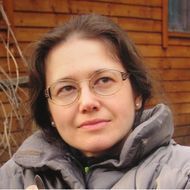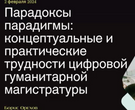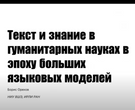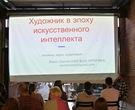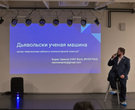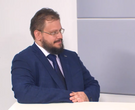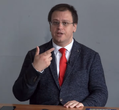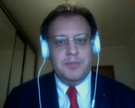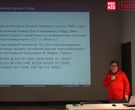- A
- A
- A
- АБB
- АБB
- АБB
- А
- А
- А
- А
- А
- Национальный исследовательский университет «Высшая школа экономики»
- Факультет гуманитарных наук
- Школа лингвистики
- Новости
- Хана Филип прочла в Школе лингвистики мини-курс лекций, посвящённый семантическому описанию грамматических значений
-
Школа
- О школе
- Сотрудники
- Семинары
-
Исследовательские подразделения
-
- Международная лаборатория языковой конвергенции
- Центр «Русский как иностранный»
- Центр цифровых гуманитарных исследований
- Центр языка и мозга
- Лаборатория по формальным моделям в лингвистике
- Лаборатория «Корпусные исследования»
- Лаборатория языков Кавказа
- Лаборатория учебных корпусов
- Лаборатория теоретической и полевой фольклористики
- Лаборатория социогуманитарных исследований Севера и Арктики
-
-
Проекты
-
Проекты сотрудников
-
Проекты студентов и аспирантов
-
Завершённые проекты
- Некомпозициональные конструкции в эритажном русском
- Компьютерные и лингвистические ресурсы для поддержки шугнанского языка
- Лингвоспецифическая разметка китайских текстов в Русско-китайском параллельном корпусе НКРЯ
- Цифровой архив: создание корпуса журнала "Отечественные записки"
- Создание лингвокультурологического подкаста о России для иностранцев «Yellow Blue Bus» (Я люблю вас)
- База данных русских идиом
- Компьютерные и корпусные инструменты для иранистических исследований
- Русский разговорный клуб
- Шугнанские глаголы в типологическом освещении
- Создание академического онлайн-словаря персидского языка
-
- Международное сотрудничество
- Экспедиции
- Ресурсы
- Препринты
- Наша книжная полка
-
Образовательные программы
- Бакалаврская программа «Фундаментальная и компьютерная лингвистика»
- Магистерская программа «Компьютерная лингвистика»
- Магистерская программа «Лингвистическая теория и описание языка»
- Магистерская программа «Русский как иностранный во взаимодействии языков и культур»
- Магистерская программа «Цифровые методы в гуманитарных науках»
- Аспирантская школа по филологическим наукам
Адрес: 105066, г. Москва,
Старая Басманная ул., д. 21/4
Телефон: +7 (495) 772-95-90 доб. 22734
E-mail: ling@hse.ru
Редакторы сайта — Наталья Борисовна Пименова, Максим Олегович Бажуков, Константин Евгеньевич Сатдаров
- Международная лаборатория языковой конвергенции
- Лаборатория «Корпусные исследования»
- Лаборатория по формальным моделям в лингвистике
- Лаборатория языков Кавказа
- Лаборатория социогуманитарных исследований Севера и Арктики
- Научно-учебная лаборатория учебных корпусов
- Центр «Русский как иностранный»
- Научно-учебные группы
- Каталог проектов по компьютерной лингвистике
- Проекты, поддерживаемые грантами
- Русский язык для всех
- Лингвистический кружок для школьников
- Лингвистика в Центре открытого образования
Школа лингвистики была образована в декабре 2014 года. Сотрудники школы преподают на образовательных программах по теоретической и компьютерной лингвистике в бакалавриате и магистратуре. Лингвистика, которой занимаются в школе, — это не только знание иностранных языков, но прежде всего наука о языке и о способах его моделирования. Научные группы школы занимаются исследованиями в области типологии, социолингвистики и ареальной лингвистики, корпусной лингвистики и лексикографии, древних языков и истории языка. Кроме того, в школе создаются лингвистические технологии и ресурсы: корпуса, обучающие тренажеры, словари и тезаурусы, технологии для электронного представления текстов культурного наследия.
В печати
Толдова С. Ю., Маслюков В. Р.
Известия РАН. Серия литературы и языка. 2026.
In bk.: Экспериментальные исследования языка: материалы конференции 2025. M.: 2025. P. 20-22.
arxiv.org. Computer Science. Cornell University, 2024

Хана Филип прочла в Школе лингвистики мини-курс лекций, посвящённый семантическому описанию грамматических значений
13 и 17 октября лекции Ханы Филип прошли в Школе лингвистики НИУ ВШЭ (Старая Басманная ул., 21/4). 15 и 16 сентября лекции читались в рамках конференции "Типология морфосинтаксических параметров".
Вторник (13 октября)
Лекция 1. Mass/count distinction: Three recent perspectives
In motivating the mass/count distinction, three perspectives have recently gained prominence. The first relies on the notion of vagueness of mass concepts/nouns, which prevents their use in counting (constructions). The second perspective focuses on non-overlap. Count nouns denotations are built from (a partition of) non-overlapping generators (individuals that count as ‘one’), while mass ones are built from overlapping generators. Counting fails when generator overlap cannot be ignored. Finally, grammatical counting is taken to depend on atomicity relative to a context (i.e., what ‘counts as one’ in a given context). Semantic atoms differ from natural atoms (what is context-independently, inherently individuated): nouns like furniture, cat are naturally atomic, but only those like cat semantically atomic and countable. Count nouns like fence are not naturally, but semantically, atomic, as they denote sets of entities indexed for the context in which they count as one.
Четверг (15 октября)
Лекция 2. Genericity and habituality
This lecture focuses on the hypothesis that linguistic means for the expression of characterizing (sentential) genericity (in the sense of Krifka et al 1995) undergo a process of grammaticalization, in contrast to kind-reference (also in the sense of Krifka et al 1995), which lacks any dedicated markers in natural languages. This provides a new independent formal argument for characterizing (sentential) genericity and kind-reference being distinct in the grammar of natural languages. To this goal, we will explore the properties of a class of markers that are variously labeled as habitual, frequentative, iterative (and the like) in traditional and descriptive grammars, showing that they resist classification as markers of tense and (imperfective) aspect, and instead exhibit properties that strongly suggest that they be best viewed as generic markers, i.e., markers of characterizing (sentential) genericity. This also provides further independent evidence in support of arguments made elsewhere that characterizing (sentential) genericity (including habituality as its special case) is a category in its own right. Given that the most typical semantic function of markers of characterizing (sentential) genericity is to encode weak descriptive generalizations, this also raises the fundamental question about whether a single unified analysis for all characterizing generics is possible.
Пятница (16 октября)
Лекция 3. Mass/count distinction: A probabilistic approach
Starting with the discussion of the merits and problems of three recent approaches to the mass/count distinction, I will outline a novel analysis of the mass/count distinction, and its embedding within either a supervaluationist. While the notions akin to vagueness, semantic atomicity and overlap are needed to ground the mass/count distinction, no single notion is sufficient to fit the whole range of data, especially intra- and crosslinguistic variation in the mass vs. count encoding. This variation is tractable by treating it as following from the interaction of vagueness (in a certain-well-defined sense) with overlap (or non-disjointness), modulo contextual factors. We formally derive four semantic classes of nouns to motivate the range of form-denotation mappings in the domain of countability, which address the challenges faced by the three recent perspectives on the mass/count distinction.
Суббота (17 октября) 10.30 - 11.50
Лекция 4. Aspectual classes and lexical aspect
This lecture explores the nature of aspectual classes, focusing on their grammatical reflexes and modeling in mereological terms, as well as with the tools of degree semantics. Aspectual classes are grammatically relevant, they correlate with certain grammatical properties of Vs, VPs, and Ss. The main focus will be on (i) the empirical grounding for lexical aspect, i.e., the classification of verbs into aspectual classes, and the way verbs of different lexical aspect classes are integrated into larger syntactic units; and (ii) the theoretical grounding of lexical aspect, and aspectual classes, in the theory of classical extensional mereology.
Суббота (17 октября) 12.10 - 13.30
Лекция 5. Grammatical aspect
This lecture deals with grammatical aspect in two core domains. The first domain concerns the (typological) question about what makes an operator perfective or imperfective. The main focus will be on so-called ‘perfective prefixes’, which have been identified as one of the key typological features of Slavic languages, most notably differentiating them from Germanic languages like German and Dutch, which also have rich systems of verbal prefixation, but without a predictable link to perfectivity/telicity. However, this view of Slavic prefixes is flawed, and has led to inadequate analyses of ‘perfective markers’ in other languages. Starting from some widely shared common-sense ideas about what it means to be a formal member of a given grammatical category system, we will raise the typological question about what makes an operator perfective or imperfective. As a case in point, Slavic prefixes will be examined and shown that they are not markers of perfectivity, Slavic perfectivization is generally a by-product of word building (derivational) processes, and a formal property of fully formed verbs, rather than of any of their parts. We conclude that Slavic aspectual systems saddle the border between the core inflectional and peripheral lexical/derivational systems, making them rather idiosyncratic representatives of aspectual systems. A major typological consequence of this proposal is that the prefixation systems in Slavic and Germanic languages are much closer to each other than is commonly assumed, neither has ‘perfective prefixes’ or ‘perfective markers’.
Прочитанные лекции доступны по ссылке.
- О ВЫШКЕ
- Цифры и факты
- Руководство и структура
- Устойчивое развитие в НИУ ВШЭ
- Преподаватели и сотрудники
- Корпуса и общежития
- Закупки
- Обращения граждан в НИУ ВШЭ
- Фонд целевого капитала
- Противодействие коррупции
- Сведения о доходах, расходах, об имуществе и обязательствах имущественного характера
- Сведения об образовательной организации
- Людям с ограниченными возможностями здоровья
- Единая платежная страница
- Работа в Вышке
- ОБРАЗОВАНИЕ
- Лицей
- Довузовская подготовка
- Олимпиады
- Прием в бакалавриат
- Вышка+
- Прием в магистратуру
- Аспирантура
- Дополнительное образование
- Центр развития карьеры
- Бизнес-инкубатор ВШЭ
- Образовательные партнерства
- Обратная связь и взаимодействие с получателями услуг
-
http://www.minobrnauki.gov.ru/
Министерство науки и высшего образования РФ
-
https://edu.gov.ru/
Министерство просвещения РФ
-
http://www.edu.ru
Федеральный портал «Российское образование»
-
https://elearning.hse.ru/mooc
Массовые открытые онлайн-курсы
- © НИУ ВШЭ 1993–2026 Адреса и контакты Условия использования материалов Политика конфиденциальности Карта сайта
- Редактору


